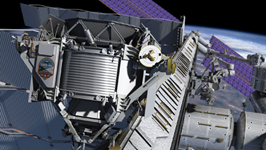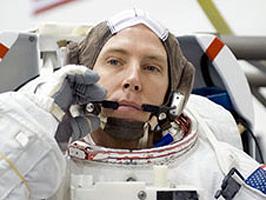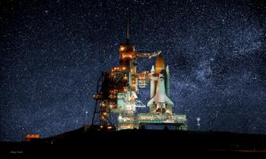Out of the quest for knowledge about the cosmos, one of the world’s most modern particle-physics detectors is being flung into space on the U.S. Space Shuttle Endeavour. In fact, this mission will form the last flight of this shuttle. This final Endeavour mission is commanded by Mark Kelly along with Gregory H Johnson as the pilot, and Mission Specialists Mike Fincke, Roberto Vittori, Greg Chamitoff, and Andrew Feustel. Besides the particle-physics and antimatter connection to TRIUMF and Canada, Feustel himself has a special connection. He studied in Canada for his Ph.D. and TRIUMF Board Chair Paul Young was his Ph.D. advisor while he was a Professor at Queen’s University. Professor Young (now Vice President Research at the University of Toronto) commented on his time working with Andrew, "It is amazing how the two of us, who at the time were working deep underground studying mining induced seismicity in the Atomic Energy of Canada’s Underground Laboratory in Manitoba, would now both be involved in some way with particle physics. Drew was a brilliant student and it is great that he realized his dream to go from deep underground to outer space!" AMS-02’s purpose is to analyze matter and antimatter as well as search for dark matter over the next 10 years while the International Space Station makes its regular orbits around the Earth. The detector will track cosmic rays from outer space with remarkable sensitivity, as it searches for lone antihelium nuclei that could signal the existence of unexpectedly large amounts of antimatter scattered throughout our universe. AMS-02 will also monitor the flux of incoming charges of particles such as protons, electrons, and atomic nuclei in the hopes of discovering more about how our universe is held together. It could bring an important contribution to the search for dark matter; if the dark matter is composed of supersymmetric particles called neutralinos, AMS-02 could detect the excess charged particles created when the neutralinos collide. This could account for approximately 25% of the total mass-energy balance of our universe. AMS-02 can also record accurate measurements of the cosmic-ray environment vital to develop countermeasures for a manned flight to Mars. For a nominal mission of three years, AMS-02 will gather an enormous amount of data which will allow for long term measurements in the variation of cosmic ray flux over a wide energy range. Along with increasing our understanding of required radiation protection for manned interplanetary flights, the data collected will hopefully lead toward understanding the origins of cosmic rays.On the fourth flight day, the crew will install the AMS-02 robotically from inside the station and shuttle. Feustel and Vittori will use the space station’s robotic Canadarm to lift the AMS out of the shuttle’s cargo bay, where the controls will shift to Johnson and Chamitoff for installation on three guideposts (called a Payload Attach System) located on the truss. What discoveries will come first with AMS-02 is hard to say, but as spokesperson and Nobel laureate Samuel J. Ting observed, there are always surprises when one brings a powerful new instrument to bear on long-standing mysteries. For more information on the AMS-02 detector, please visit the official website at www.ams02.org or NASA's official page for the detector at www.ams.nasa.gov. We wish the Space Shuttle Endeavour and its crew success in their mission!
-- Written by Lindsay Davies, Communications Assistant |
The Space Shuttle Endeavour against a starry night bakground. Courtesy of A. Feustel. |
Canada's particle accelerator centre
Centre canadien d'accélération des particules
Centre canadien d'accélération des particules



